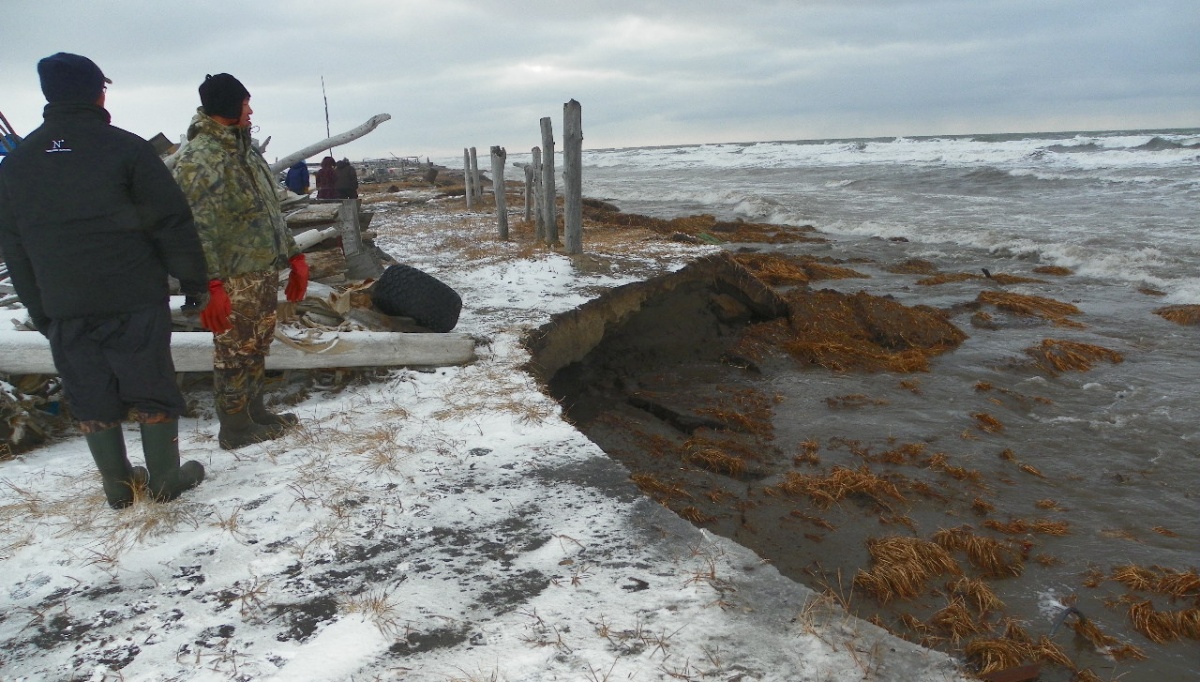To relocate Alaska villages, we need to reexamine the costs
Harnessing technological innovations such as 3D-printed housing can help alleviate financial constraints of resettlement.

In 2018, Alaska added a new category to its State Hazard Mitigation Plan: usteq, a Yup’ik word used to describe the compounding effects of permafrost thaw, flooding, and erosion that threaten catastrophic land collapse. For many Indigenous communities, usteq imposes a critical threat to housing, public infrastructure, culturally significant locations, and the environment. In response to this phenomenon, members of the Alaska village of Shishmaref voted in 2016 to relocate their community from a barrier island to a nearby mainland site, an act which drew international media coverage. Due to a lack of financial support from the state and federal governments, however, Shishmaref has not yet successfully relocated. The estimated cost of resettlement? A staggering $180 million.
This figure has been cited in reports as recent as 2019, but it is originally from a “Shishmaref Relocation and Collocation Study” commissioned by the U.S. Army Corps of Engineers in 2004. Instead of accepting these estimates as is, we should take into account technological innovations that have emerged in the past 16 years. In particular, 3D-printed housing is one cost-saving technology that may lower logistical expenses significantly.
According to the 2004 report, relocating approximately 596 people in Shishmaref requires a combination of moving 137 existing homes and barging in 13 new homes from Anchorage or Seattle. This process costs an estimated $14 million and does not include the cost of connecting the homes to utilities. Today, a 3D-printed home can be built for around $10,000 in material costs and very little labor costs due to the automated nature of the process, making this less expensive than both moving homes and conventional construction. The current population of Shishmaref has not changed significantly from that of 2004. Building 150 new homes via 3D printing could cost a fraction of the original estimate. In total, relocation costs associated with establishing residential, commercial, industrial, and public storage buildings constitute an estimated $50 million. Where possible, construction via 3D printing would help alleviate the financial constraints of such an endeavor.
While the technology is relatively new, its application towards affordable housing would not be entirely novel. Recently, the nonprofits New Story and Mexico-based Échale partnered with robotic construction company ICON to construct built-to-last 3D-printed housing for families living in extreme poverty in Tabasco, Mexico. This project can serve as a case study on how entities in Alaska might proceed with a similar initiative.
Moreover, the technology has been tested in cold climates. In 2017, the startup Apis Cor constructed a 3D-printed residential home outside Moscow, a project which was completed in the winter in approximately 24 hours. The company claimed that their equipment could operate at temperatures as low as minus 35 degrees Celsuis. The largest 3D-printed building stands at two stories with a total area of 640 square meters (6,888 square feet), allowing the possibility of using this technology for non-residential buildings, too.
A partnership between Alaska communities looking to relocate and companies that manufacture 3D-printed homes could benefit both parties. The flexibility of the architectural style can accommodate citizen participation in the design process, which may serve to lessen some of the social and psychological costs of resettlement. Given the high-profile coverage of Shishmaref’s relocation initiative, a technology company will likely receive positive press from this partnership. This, along with the larger scale of such a project, may enable negotiation for a less expensive price tag per house.
Of course, a relocation framework would need to consider less tangible but equally important aspects of resettlement, such as ensuring social cohesion and preserving the community’s cultural heritage. Relocation should be framed not as a consequence of failure but as opportunity for growth and evolution of the community. There are now documented cases of successful retreat from natural hazard risk around the globe, from Kiruna, Sweden, to Panabaj and Tz’anchaj, Guatemala. Lessons can be gleaned from these cases to serve as guiding practices for relocation of Alaska communities.
To be clear, resettlement still requires a significant amount of funding, coordination, and resources, and at present, there is no dedicated funding stream, lead agency, or policy framework to guide Alaska communities in need of relocation. The state of Alaska and the U.S. federal government have an obligation to the people of these communities. Without an up-to-date understanding of the costs and benefits, the debate surrounding the extent to which taxpayers are responsible for resettlement of Shishmaref and similar communities will only become more muddled. It is a debate that will become increasingly urgent in the coming years. Shishmaref is not the only Alaska village that has voted to relocate in recent times; Newtok and Kivalina have also done so. Therefore, it is imperative to both update the now 16-year-old cost estimate and incorporate creative, cost-effective solutions available today.
Michelle Xiyue Li is a PhD student in public policy at Harvard University and a pre-doctoral fellow of the Harvard Environmental Economics Program.

The views expressed here are the writer’s and are not necessarily endorsed by the Arctic Initiative or ArcticToday, which welcomes a broad range of viewpoints. To submit a piece for consideration, email commentary (at) arctictoday.com.